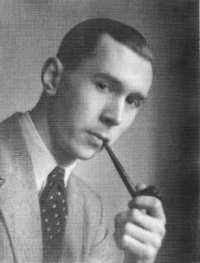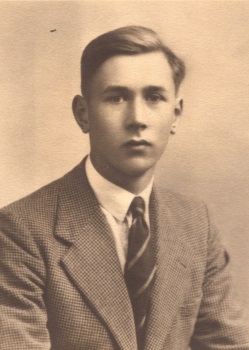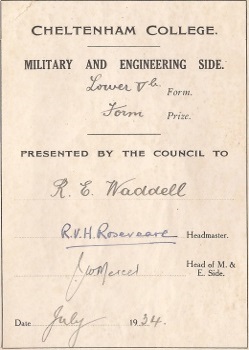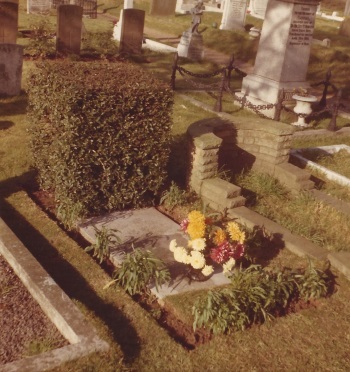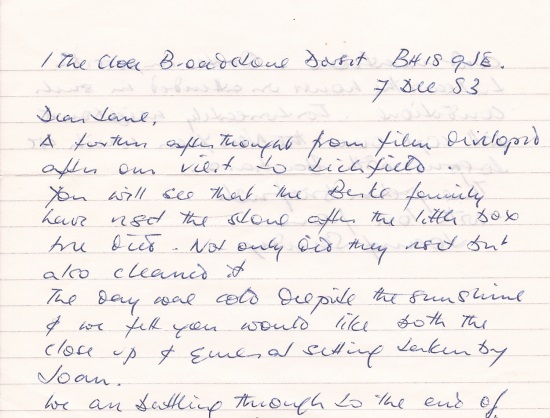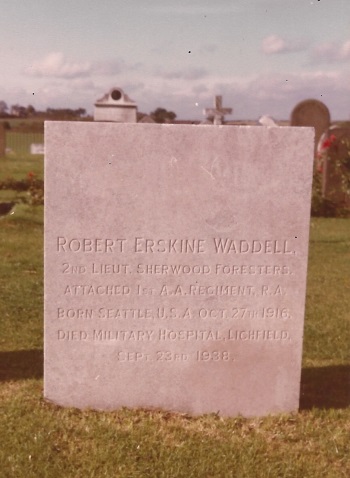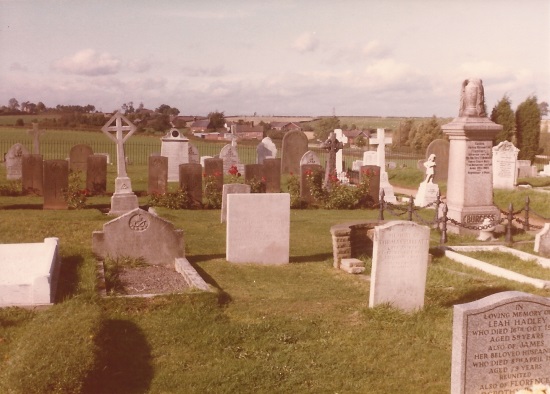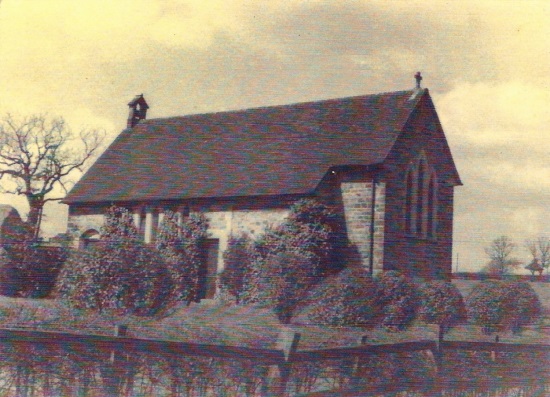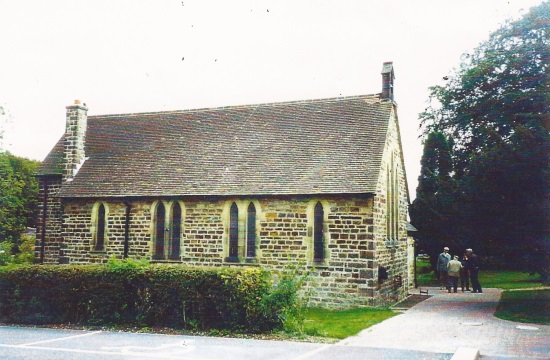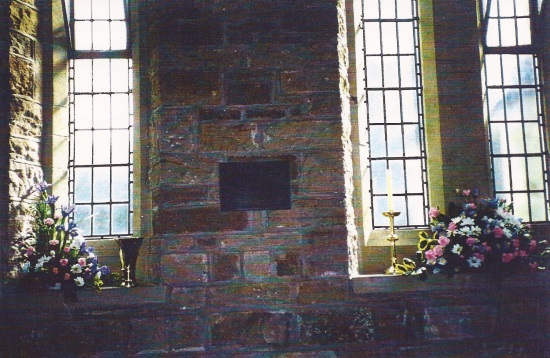Robert Erskine (Robin) Waddell
27 Oct 1916 – 23 Sep 1938
The portrait photograph on the right was taken via a mirror by Robin himself, an enthusiastic and innovative photographer who developed his pictures himself in his own darkroom.
His clean-cut good looks and impressively mature persona are remarkable for a young man scarcely entered into his twenties. Within two years, however, he was dead.
The narrative that follows is transcribed from Alexander (Sandy) Waddell's invaluable summary in his biographical document WADDELL LINE WHO'S WHO.
Please note that the dates Sandy gives for Robin's birth and death differ significantly from the dates recorded on his gravestone, as displayed in the section Mors Janua Vitae.
Summary transcript
Born second child and son of Robert Waddell and Jessie Frances Hannah née Findlay at Seattle, Washington, USA on 23 Sep 1916, thus a citizen of the United States (like his elder brother Walter). Came to England with his parents and brother Walter, a wartime Atlantic passage aboard ss Orduna. Educated at St George's School, Windsor as a Choirboy of St George's Chapel between 1926 and 1930, and then Cheltenham College on the Military side. His ambition to join the Royal Air Force was thwarted by medical rejection of some heart problem1. This could not be accepted by the family GP Dr Andrew M Duthie [President of the Chesterfield & District Caledonian Association, 1929-1931!], though no appeal was possible. The Police Service was considered but eventually he studied to gain a permanent commission through TA2 service
Meanwhile he had employment with Messrs Robinson3 at their Portland works, and was commissioned 2nd Lieutenant in the 40th Battery RE4 TA (Sherwood Foresters). He had many talents and apart from his considerable skill in photography combined a light tenor voice with acting skills, a great [asset] to the Operatic Society of Robinson and Sons, and considerable fluency in French.
In Aug 1938, at the time of the 'false mobilisation' a year prior to the outbreak of the Second World War, he decided to resign his employment and transfer to the Regular Army. He went to Whittington Barracks near Lichfield, for attachment to the 1st AA5 Regiment, RA6. For this he had required exemption from any obligation to serve in the American forces. [He began to suffer an acute ongoing headache7 during the train journey to Lichfield.] He was taken ill on parade on Wednesday 21 Sep and despite every effort by the medical teams he died of infantile paralysis8 late that evening. Although the authorities had managed to obtain one of the then-few iron lungs from London to be delivered specially by the night train to Whittington Halt it was of no avail. He was buried with full military honours at Whittington Church on Saturday 24 Sep. He had made many friends in Chesterfield and during his brief time at Whittington had showed great promise.
| 1: | Aunt Jane maintains the problem was colour-blindness |
| 2: | Territorial Army |
| 3: | Robinson and Sons Ltd, textile and packaging manufacturers, Chesterfield |
| 4: | Royal Engineers |
| 5: | Anti-Aircraft |
| 6: | Royal Artillery |
| 7: | According to Aunt Jane |
| 8: | More commonly called poliomyelitis, or in his case paralytic poliomyelitis. I find it almost quite incredible that the advent of such a serious infection could have gone entirely unnoticed by all those around him, let alone by Robin himself, until it was too late. Perhaps he was especially susceptible, so that the average incubation period of about a week was somehow fast-tracked. |
Education
Nothing is now known about Robin's formal education before the age of eight. How I wish I'd asked Aunt Jane about this while there was still the opportunity. At that age, however, he gained a place at St George's School, Windsor1, 2, as a choirboy at St George's Chapel1, 2 in Windsor Castle. He must evidently have possessed an exceptionally clear treble voice, and already have mastered the rudiments of reading music. But he didn't seem to be academic – Old Grannie, his paternal grandmother, had already spread the rumour that he was 'slow'. But at the critical juncture, on the day, when the interviewing committee had gone into a huddle to review the relative merits of the candidates, they reached an impasse – a janissary was sent to put his head round the waiting-room door – "Did any of the boys know their alphabet backwards?". Robin leapt to his feet – he was left-handed so this was no problem – and the result was history.
I'm very grateful to Mr Anthony Brailsford, the Archivist of St George's School Windsor, for details of Robin's career at St George's, extracted from his obituary in the School Magazine for the Christmas Term 1938:
Robin came to the school in May 1925, and left in April 1931. During those six years he endeared himself to everybody by the charm of his personality, his cheery good nature and his pleasing sense of humour. Few boys can have left such pleasant memories behind them. He was a plucky football player, and in the choir he became leader of the Cantoris [at St George's Chapel, Windsor Castle]. From St George's he went to Cheltenham College ...
I'm very grateful to Mrs Jill Barlow of their Archives Section for details of Robin's career at Cheltenham College.
In May 1931, I suppose when his voice was breaking, or had broken, so that his choral career was over, Robin was sent to Cheltenham College1, 2 (first as a day boy, staying with Aunt Val Gueritz in nearby Lansdown Parade, and then as a boarder in Newick house) on the Military & Engineering rather than the Classics side – an early reflection of his subsequent career interests? Or just an aversion to the Iliad and the Gallic Wars? Within the family he was namely for The Canterbury Tales, and was awarded a copy of The Complete Works of Geoffrey Chaucer as the Lower Vb Form Prize in 1934, duly legitimised by the signature of the Headmaster, R V H Roseveare.
Robin was by now 17½ and in fact would leave five months later in Dec 1934. During his first year he had been inflicted with a broken arm during a game of rugby. The arm had been duly attended to, and he'd certainly been excused games until it had fully healed. In his very first game thereafter, however, his other arm got broken, and Aunt Jane rather thought that he was then signed-off from rugby for good. Apart from that, his school career had been steady and uneventful – not a great brain perhaps, but a most likeable and resourceful boy with an impish sense of humour1.
He had taken regular piano lessons, though to what standard isn't recorded, and he played the clarinet in the College Band. Indeed, in 1932 he had been awarded a Music Prize. But despite his mellifluous tenor singing voice, and his keenness on 'am dram', there is no record of him on the cast lists of any College operatic or dramatic productions
As can be seen on the prize bookplate, he was in the B stream academically, and in fact only seems to have achieved four Credits in the School (Leaving) Certificate examinations at the first attempt in Jun 1934 – English, History, Elementary Maths, and Physics. The system was that for each subject taken you were graded as [Fail,] Pass, Credit or Distinction. To be awarded the Certificate, you had to sit (at least) six subjects and get (at least) five Credits and one Pass. If you failed, you had to resit the whole thing, either in Dec the same year or Jul the following year.
In fact he stayed just the extra term, sitting College exams in English, French, maths, chemistry, physics and geometric drawing, and then resitting the School Certificate examination in Dec 1934. He passed, doubtless to his own relief and the delight of the family. Life stretched out before him ...
| 1: | These qualities are marvellously evidenced in Aunt Jane's narrative "Summer Holiday 1928". He also had a great gift for parody; family lore tells of his ability to improvise entertainingly bogus Chaucerian episodes at the dinner table, and there still survives his pastiche (part 1 and part 2) of Beachcomber's bizarre and surrealistic style of humour. |
Family
For reasons investigated in the "Sunderings" section of the profile of my father Walter (aka William), there was a gap of over 2½ years between Walter's birth and Robin's arrival, and then a further gap of 2½ years until Sandy's arrival. Frances and Jane then arrived in rapid succession. Robin was therefore the family's centre of gravity (and given his happy temperament, the centre of levity also).
His death devastated the family. Robert, already at a low ebb following the loss of his job in a board-room reshuffle at Brown Bayley's the year before, never recovered emotionally, in the opinion of Aunt Jane. And she recalled that Hannah, despite the depth of her religious faith, went over and over again to see Snow White, which had been Robin's favourite film, to maintain some form of contact with him.
Awful things do happen. But remembering earlier and happier times can help. Here are three family photographs, all involving Robin. The first is rather smudgy, and the third is rather puzzling (it's Robin and perhaps Walter, though the face is partially obscured, but why are they so identically dressed? Not school uniform, as they attended different schools. Page boys at a wedding? Suggestions would be welcomed).
And lastly, an epitaph from Hannah, a copy of which she affixed to that photograph of Robin at the age of 18 or so, and kept by her ever after:
The Noble Nature
It is not growing like a tree
In bulk, doth make a man better be;
Or standing long an oak, three hundred year,
To fall a log at last, dry, bald and sere:
A lily of a day
Is fairer far in May,
Although it fall and die that night
It was the plant and flower of light.
In small proportions we just beauties see
And in short measures life may perfect be.
Ben Jonson
1572-1637
Mors Janua Vitae
I'm very grateful to Mr Anthony Brailsford, the Archivist of St George's School Windsor, for the following extract from Robin's obituary in the School Magazine for the Christmas Term 1938:
... and on leaving Cheltenham he joined a firm at Chesterfield. But his heart was not in his work, and he decided to get into the regular army through the Territorials. He became a Second Lieutenant in the 40th A.A. Battery, Sherwood Foresters (T.A.), and in August he went to Lichfield for a six weeks' training course with the 1st A.A. Regiment, R.A. On September 21st he was suddenly stricken with infantile paralysis, and passed away on the 23rd, to the great grief of his comrades, with whom he was deservedly popular. He was buried with full military honours at Whittington Church, near Lichfield.
The sympathy of all at St George's went out to Robin's parents, and brothers and sisters.
Lichfield Barracks, more properly known as Whittington Barracks, were (and still are) located in the village of Whittington a few miles from Lichfield city centre, and in fact have (or had) their own railway station, Whittington Halt, mentioned earlier.
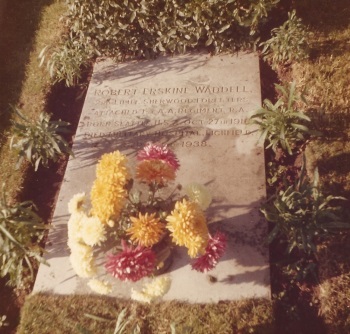
ROBERT ERSKINE WADDELL
2ND LIEUT. SHERWOOD FORESTERS
ATTACHED 1ST A.A. REGIMENT, R.A.
BORN SEATTLE, U.S.A., OCT 27TH 1916
DIED MILITARY HOSPITAL, LICHFIELD
SEP 23RD 1938
This photograph is due to Uncle Sandy (though no date is given), and I am now fairly confident that it was taken in the churchyard of St Giles Whittington, Church Street, Whittington WS14 9LE.
Something very odd is evident on this gravestone, in that the dates of Uncle Robin's birth and death are completely at variance with those chronicled by Uncle Sandy (ie 23 Sep 1916 – 21 Sep 1938). With no disrespect to anybody specifically, what sort of a situation was this, in which even ones brother's birthday wasn't correctly known? It's hard to comprehend such a collective disconnect.
Here we see things from a different angle, but still gain no perspective on the extraordinary mismatch much more clearly legible in the previous photograph.
I could get quite emotional about this – not just from a family viewpoint, but in the way that the Fallen (in the Great War particularly) were officially accorded a great deal more respect in death (thanks to the admirable Commonwealth War Graves Commission§) than in their civilian lives or their brief ill-equipped existences facing the implacably devastating enemy – who two generations later would anyway become Britain's trading partners and political allies.
§In the run-up to the centenary of 4 Aug 1914 and three-quarter centenary of 3 Sep 1939, their remarkable dedication should also be recognised, not just in the UK and Europe but in Asia too. And in Dublin, the Sherwood Foresters suffered disastrous casualties in the opening stages of the Easter Uprising of 1916, though the CWGC's remit is more tenuous there.
At a later date – in a letter to his sister Jane, dated 7 Dec 1983, Sandy wrote (in his beautiful but well-nigh illegible calligraphy):
"A further afterthought from film developed after our visit to Lichfield. You will see that the B??ke family have reset the stone after the little box tree died. Not only did they reset but also cleaned it.
The day was cold despite the sunshine and we felt that you would like both the close-up and general setting taken by Joan."
Well, I find this very puzzling – who were, or indeed are, this excellent but incompletely legible family (possibly Burke) who (presumably at considerable expense) were maintaining Robin's grave. Why weren't the Waddell family taking care of it? There is no-one in our family left alive to answer these questions. Perhaps when the location has been confidently established, official records will be easier to access, and the truth can be established.
It was very noticeable, even to myself as a child, that nobody at Elm Lodge ever talked openly about Robert Waddell, though there was a rather grumpy photograph of him in the sitting room. And now I reflect on the matter, not only did nobody mention Robert, they rarely if ever mentioned Robin either, except occasionally to say he tended to write things backwards (being left-handed) or to mention his love of Chaucer – and there wasn't a single photograph of him in evidence. He was almost like the lost son in Who's Afraid Of Virginia Woolf.
There were other strange aspects of the muted family response at the time of his death that don't need to be dwelt upon – though if he did die on 23 Sep and was buried on 24 Sep then there was indeed very little time for them to do so – but let's now turn to the nice brass memorial plate that was placed in Walton Church, presumably in late 1938 or early 1939, in Robin's memory. But more uncertainties must be addressed: firstly, where was (and still is) Walton? It was a village, now a suburb, south-west of Chesterfield, down the A632 to Matlock. And Walton Church? I think it must be St John's Church (S42 7LT) at the junction of Matlock Road with Walton Back Lane.
Originally built in 1917, it was still in the 1930's quite a modest size and structure, little more than a chapel:
and still was in 1998, seen from the other side, with Sandy chatting to the Oldest Inhabitant bottom right:
The location, at least, of the memorial plate can be seen in this photograph in which the flash appears to have seriously malfunctioned:
though the plate itself in close-up is fortunately at least partially legible:
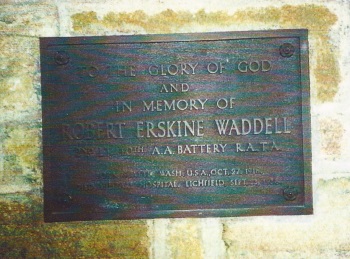
TO THE GLORY OF GOD
AND
IN MEMORY OF
ROBERT ERSKINE WADDELL
2ND LT 10TH A.A. BATTERY R.A. T.A.
BORN SEATTLE WASH. U.S.A OCT 27 1916
DIED MILITARY HOSPITAL, LICHFIELD, SEPT 23 1938
And there it might have stayed until the last syllable of recorded time, had the original church not been demolished and rebuilt in 2006, as outlined in a local website. I've contacted their office about the consequences of this for Robin's memorial, and have had a very nice reply to say:
"... The memorial is in the 'history corner' of the new church so it is still on public display, although our Estates Manager [has] said that we do not know a lot about the history of any of the three plaques, which includes your [uncle] ..."


